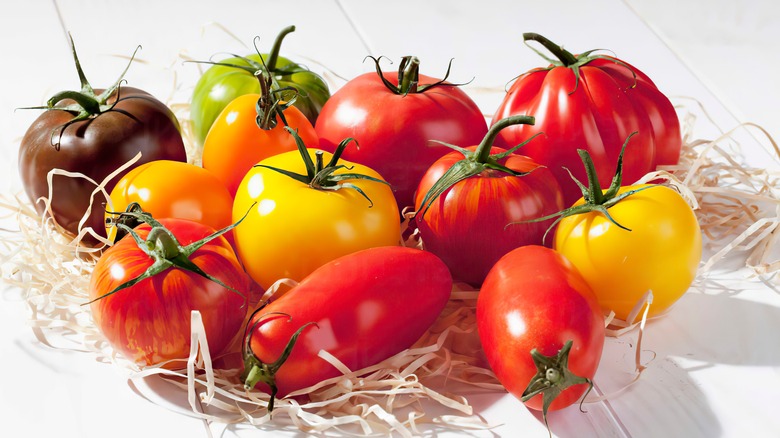Why Vintage Tomatoes Are Totally Unrecognizable
Oh tomatoes: What would we do without them? Italy's pasta dinners wouldn't be as tasty without tomato sauce. In Spain, paella would be a shell of its former self. Mexican fare, with its many salsas, would be a totally different ball game. Citing 2018 data, World Atlas ranked them as the most popular fruit on Earth, based on the sheer tonnage produced – approximately 200 million tons (182 million metric tons). In 2017, BBC contributor Dr. Michael Mosley argued that an amino acid found in tomatoes, glutamate, makes people crave them and may explain their global appeal.
There was a point in history when loving them didn't seem inevitable or even likely in large parts of the world. Believe it or not, Europe did not become familiar with tomatoes until the 1500s when explorers came back from the Americas, according to the University of Illinois at Urbana-Champaign. Europeans who laid eyes on the tomato all those centuries ago did not view it the same way people do now. If fact, the fruit didn't even look the way modern people may have come to expect.
Tomatoes looked different
The vintage tomatoes that Europeans first encountered were a whole different (plant-based) animal. For one thing, the term "tomato red" wouldn't have made much sense at all since the fruit was more likely to be yellow, according to The Spruce Eats. The outlet points out that people in Italy and Spain referred to tomatoes as "yellow apples," or "pomi d'oro." Per the Campbell's Soup website, Germany knew the fruit as the "gold apple," or "goldapfel" (via the Langenscheidt Dictionary). Size-wise, it was probably similar to a cherry.
For about two centuries, many Europeans were petrified by the thought of eating tomatoes, writes Smithsonian, which notes that they were known to many as "poison apples" due to their suspected role in the deaths of aristocrats. However, the lethal lead contained in the pewter plates they used was the likely culprit. Yet the fear wasn't totally unfounded since tomatoes are related to the deadly nightshade, and their leaves are, indeed, poisonous.
Tomatoes began to turn a new leaf in the minds of many people during the 19th century. Even then, the public had to overcome its aversion to the tomato worm, which was wrongly thought to be deadly to humans. But fear failed to foil tomatoes in the end. Farmers tested different varieties, and when it was discovered that the acidity of tomatoes made them well-suited for canning, demand for the canned stuff rose.

